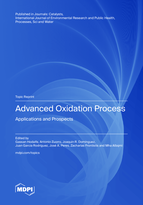Topic Menu
► Topic MenuTopic Editors



2. Instituto Universitario de Investigación del Agua, Cambio Climático y Sostenibilidad (IACYS), Avda de la Investigación s/n, 06006 Badajoz, Spain




Advanced Oxidation Process: Applications and Prospects

A printed edition is available here.
Topic Information
Dear Colleagues,
Within the last twenty years, advanced oxidation technologies have begun to be taken seriously as green technologies and are highly efficient from the point of view of final yields since they are chemical reactions that can be controlled and directed according to the end goals in each case. Thus far, they have considered emerging technologies to be of little application at the industrial level as they are commonly considered relatively expensive technologies compared with conventional technologies. This consideration previously indicated is not entirely true since, in many cases, the costs of these technologies can be low as they are simple technologies and the costs of the chemical reagents used depend on each geographical area. Without forgetting to mention the degree of previous optimization of these technologies in each case, which usually implies a notable reduction in costs, especially when considering the circular economy of the processes in which these technologies are applied.
Advanced oxidation technologies are technologies that can be used individually or incorporated into more complete processes or bioprocesses. In this sense and as a non-limiting example, they can be applied in wastewater treatment as a main technology/for pretreatment or as a final operation for the adjustment of the final percentages required by current legislation.
This Special Volume is characterized by being a multidisciplinary volume of the journals Catalysts, Processes, Sci, International Journal of Environmental Research and Public Health, and Water, in which the aim is to extend our knowledge of the current state-of-the-art related to current and possible future applications of advanced oxidation processes.
Prof. Dr. Gassan Hodaifa
Prof. Dr. Antonio Zuorro
Dr. Joaquín R. Dominguez
Prof. Dr. Juan García Rodríguez
Prof. Dr. José A. Peres
Dr. Zacharias Frontistis
Dr. Mha Albqmi
Topic Editors
Keywords
- advanced oxidation processes
- chemical oxidation
- Fenton reaction
- photolysis
- photo-Fenton
- nanoparticles for oxidation
Participating Journals
| Journal Name | Impact Factor | CiteScore | Launched Year | First Decision (median) | APC |
|---|---|---|---|---|---|

Catalysts
|
3.9 | 6.3 | 2011 | 14.3 Days | CHF 2700 |

International Journal of Environmental Research and Public Health
|
- | 5.4 | 2004 | 29.6 Days | CHF 2500 |

Processes
|
3.5 | 4.7 | 2013 | 13.7 Days | CHF 2400 |

Sci
|
- | 3.1 | 2019 | 47.7 Days | CHF 1200 |

Water
|
3.4 | 5.5 | 2009 | 16.5 Days | CHF 2600 |

MDPI Topics is cooperating with Preprints.org and has built a direct connection between MDPI journals and Preprints.org. Authors are encouraged to enjoy the benefits by posting a preprint at Preprints.org prior to publication:
- Immediately share your ideas ahead of publication and establish your research priority;
- Protect your idea from being stolen with this time-stamped preprint article;
- Enhance the exposure and impact of your research;
- Receive feedback from your peers in advance;
- Have it indexed in Web of Science (Preprint Citation Index), Google Scholar, Crossref, SHARE, PrePubMed, Scilit and Europe PMC.

